
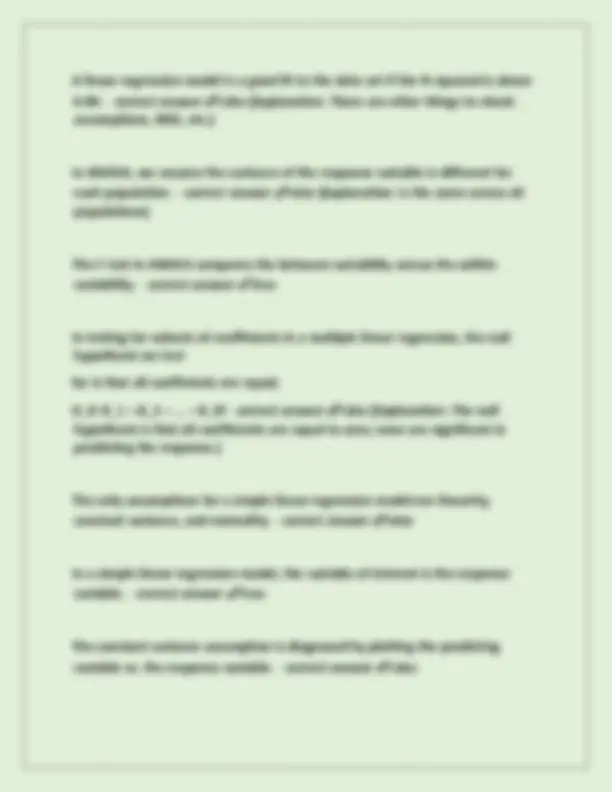
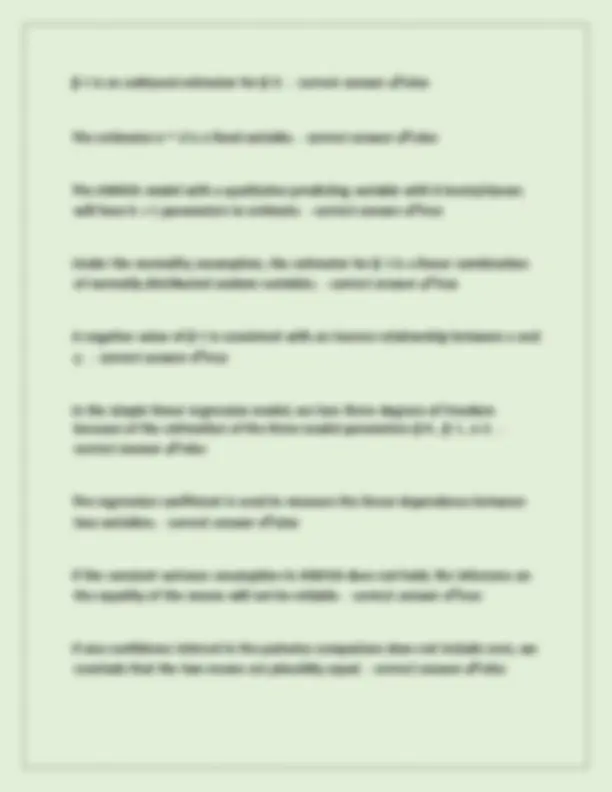
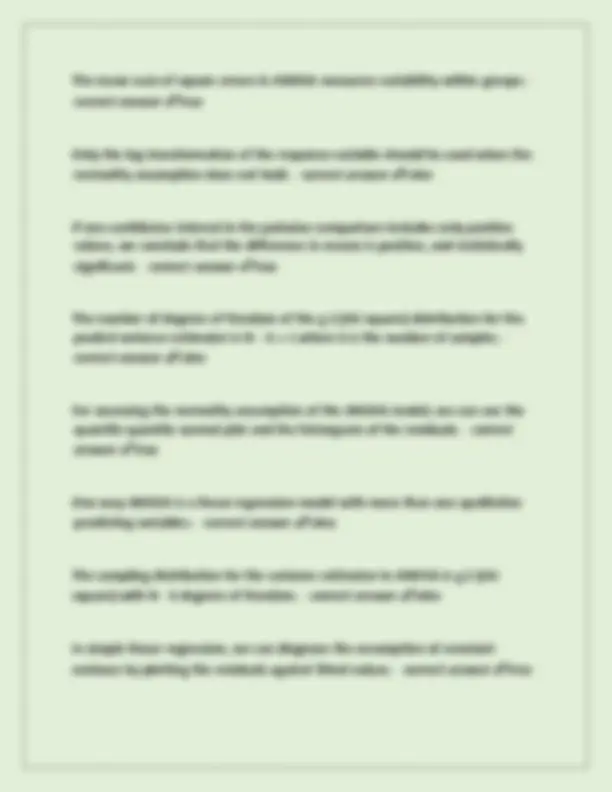

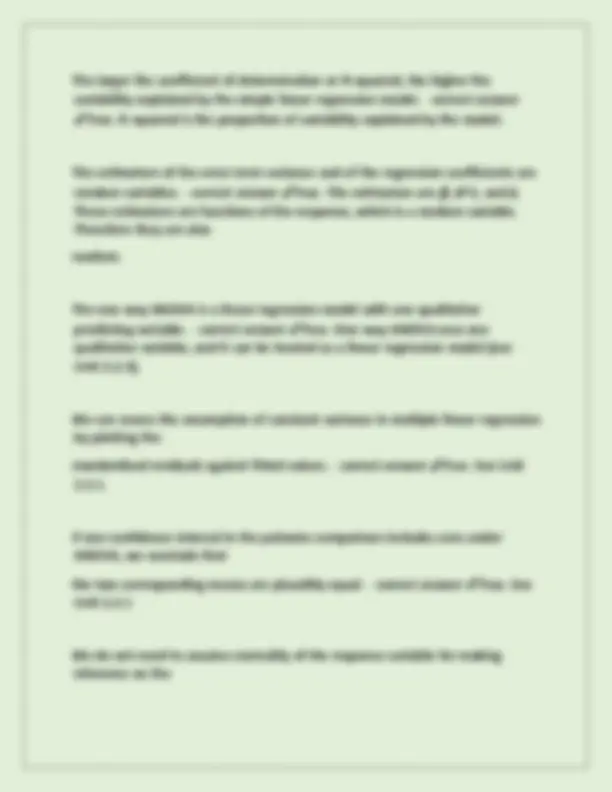
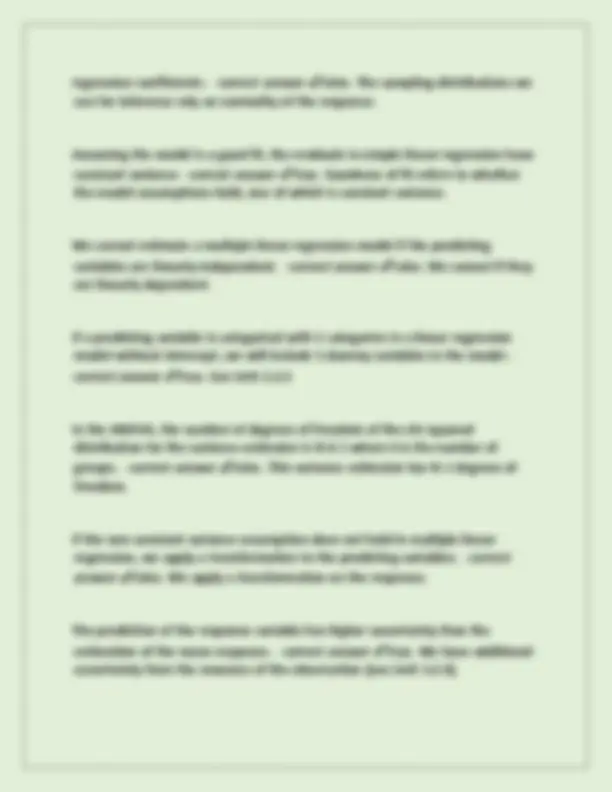


Study with the several resources on Docsity

Earn points by helping other students or get them with a premium plan


Prepare for your exams
Study with the several resources on Docsity

Earn points to download
Earn points by helping other students or get them with a premium plan
Community
Ask the community for help and clear up your study doubts
Discover the best universities in your country according to Docsity users
Free resources
Download our free guides on studying techniques, anxiety management strategies, and thesis advice from Docsity tutors
ISYE 6414 Midterm exam with answers
Typology: Exams
1 / 11

This page cannot be seen from the preview
Don't miss anything!







We |can |assess |the |constant |variance |assumption |in |linear |regression |by |plotting |the |residuals |vs. |fitted |values. |- |correct |answer |✔True
If |one |confidence |interval |in |the |pairwise |comparison |in |ANOVA |includes |zero, |we |conclude |that |the |two |corresponding |means |are |plausibly |equal. |- |correct |answer |✔True
The |assumption |of |normality |is |not |required |in |linear |regression |to |make |inference |on |the |regression |coefficients. |- |correct |answer |✔False |(Explanation: |is |required)
We |cannot |estimate |a |multiple |linear |regression |model |if |the |predicting |variables |are |linearly |independent. |- |correct |answer |✔False |(Explanation: |linearly |dependent)
If |a |predicting |variable |is |a |categorical |variable |with | 5 |categories |in |a |linear |regression |model |without |intercept, |we |will |include | 5 |dummy |variables. |- |correct |answer |✔True
If |the |normality |assumption |does |not |hold |for |a |regression, |we |may |use |a |transformation |on |the |response |variable. |- |correct |answer |✔True
The |prediction |of |the |response |variable |has |higher |uncertainty |than |the |estimation |of |the |mean |response. |- |correct |answer |✔True
Statistical |inference |for |linear |regression |under |normality |relies |on |large |sample |size. |- |correct |answer |✔False |(Explanation: |small |sample |size |is |fine)
A |nonlinear |relationship |between |the |response |variable |and |a |predicting |variable |cannot |be |modeled |using |regression. |- |correct |answer |✔False |(Explanation: |Nonlinear |relationships |can |often |be |modeled |using |linear |regression |by |including |polynomial |terms |of |the |predicting |variable, |for |example.)
Assumption |of |normality |in |linear |regression |is |required |for |confidence |intervals, |prediction |intervals, |and |hypothesis |testing. |- |correct |answer |✔True
If |the |confidence |interval |for |a |regression |coefficient |contains |the |value |zero, |we |interpret |that |the |regression |coefficient |is |plausibly |equal |to |zero. |- |correct |answer |✔True
The |smaller |the |coefficient |of |determination |or |R-squared, |the |higher |the |variability |explained |bythe |simple |linear |regression. |- |correct |answer |✔False |(Explanation: |The |larger |the |R-squared)
The |estimators |of |the |variance |parameter |and |of |the |regression |coefficients |in |a |regression |model |are |random |variables. |- |correct |answer |✔True
The |standard |error |in |linear |regression |indicates |how |far |the |data |points |are |from |the |regression |line, |on |average. |- |correct |answer |✔True
β | 1 |is |an |unbiased |estimator |for | β | 0 |. |- |correct |answer |✔False
The |estimator | σ |^ | 2 |is |a |fixed |variable. |- |correct |answer |✔False
The |ANOVA |model |with |a |qualitative |predicting |variable |with |k |levels/classes |will |have |k |+ | 1 |parameters |to |estimate. |- |correct |answer |✔True
Under |the |normality |assumption, |the |estimator |for | β | 1 |is |a |linear |combination |of |normally |distributed |random |variables. |- |correct |answer |✔True
A |negative |value |of | β | 1 |is |consistent |with |an |inverse |relationship |between |x |and |y |. |- |correct |answer |✔True
In |the |simple |linear |regression |model, |we |lose |three |degrees |of |freedom |because |of |the |estimation |of |the |three |model |parameters | β | 0 |, | β | 1 |, | σ | 2 |. |- |correct |answer |✔False
The |regression |coefficient |is |used |to |measure |the |linear |dependence |between |two |variables. |- |correct |answer |✔False
If |the |constant |variance |assumption |in |ANOVA |does |not |hold, |the |inference |on |the |equality |of |the |means |will |not |be |reliable. |- |correct |answer |✔True
If |one |confidence |interval |in |the |pairwise |comparison |does |not |include |zero, |we |conclude |that |the |two |means |are |plausibly |equal. |- |correct |answer |✔False
The |mean |sum |of |square |errors |in |ANOVA |measures |variability |within |groups. |- |correct |answer |✔True
Only |the |log-transformation |of |the |response |variable |should |be |used |when |the |normality |assumption |does |not |hold. |- |correct |answer |✔False
If |one |confidence |interval |in |the |pairwise |comparison |includes |only |positive |values, |we |conclude |that |the |difference |in |means |is |positive, |and |statistically |significant. |- |correct |answer |✔True
The |number |of |degrees |of |freedom |of |the | χ | 2 |(chi-square) |distribution |for |the |pooled |variance |estimator |is |N | − |k |+ | 1 |where |k |is |the |number |of |samples. |- |correct |answer |✔False
For |assessing |the |normality |assumption |of |the |ANOVA |model, |we |can |use |the |quantile-quantile |normal |plot |and |the |historgram |of |the |residuals. |- |correct |answer |✔True
One-way |ANOVA |is |a |linear |regression |model |with |more |than |one |qualitative |predicting |variables. |- |correct |answer |✔False
The |sampling |distribution |for |the |variance |estimator |in |ANOVA |is | χ | 2 |(chi- square) |with |N |- |k |degrees |of |freedom. |- |correct |answer |✔False
In |simple |linear |regression, |we |can |diagnose |the |assumption |of |constant- variance |by |plotting |the |residuals |against |fitted |values. |- |correct |answer |✔True
Let |Y^∗ |be |the |predicted |response |at |x^∗ |. |The |variance |of |Y^∗ |given |x^∗ |depends |on |both |the |value |of |x^∗ |and |the |design |matrix. |- |correct |answer |✔True |(but |the |wording |was |confusing, |so |everyone |got |credit |no |matter |what |on |this |question)
Suppose |x1 |was |not |found |to |be |significant |in |the |model |specified |with |lm(y |~ |x1 |+ |x2 |+ |x3). |Then |x1 |will |also |not |be |significant |in |the |model |lm(y |~ |x1 |+ |x2). |- |correct |answer |✔False
When |estimating |confidence |values |for |the |mean |response |for |all |instances |of |the |predicting |variables, |we |should |use |a |critical |point |based |on |the |F- distribution |to |correct |for |the |simultaneous |inference. |- |correct |answer |✔True
For |estimating |confidence |intervals |for |the |regression |coefficients, |the |sampling |distribution |used |is |a |normal |distribution. |- |correct |answer |✔False
In |a |multiple |linear |regression |model |with |quantitative |predictors, |the |coefficient |corresponding |to |one |predictor |is |interpreted |as |the |estimated |expected |change |in |the |response |variable |when |there |is |a |one |unit |change |in |that |predictor. |- |correct |answer |✔False
It |is |possible |to |produce |a |model |where |the |overall |F-statistic |is |significant |but |all |the |regression |coefficients |have |insignificant |t-statistics. |- |correct |answer |✔True. |(explanation: |This |can |happen |when |you |have |multicollinearity |in |two |or |more |of |the |predictors. |In |that |case, |you |have |an |overall |model |which |is |significant |but |on |the |level |of |individual |predictor, |they |might |not |be |since |either |of |the |collinear |features |could |be |included.)
Analysis |of |Variance |(ANOVA) |is |an |example |of |a |multiple |regression |model. |- |correct |answer |✔True
For |a |multiple |regression |model, |both |the |true |errors | ϵ |and |the |estimated |residuals | ϵ -hat |have |a |constant |mean |and |a |constant |variance. |- |correct |answer |✔False
If |the |p-value |of |the |overall |F-test |is |close |to |0, |we |can |conclude |all |the |predicting |variable |coefficients |are |significantly |nonzero. |- |correct |answer |✔False
The |causation |effect |of |a |predicting |variable |to |the |response |variable |can |be |captured |using |multiple |linear |regression, |conditional |of |other |predicting |variables |in |the |model. |- |correct |answer |✔False
A |high |Cook's |distance |for |a |particular |observation |suggests |that |the |observation |could |be |an |influential |point. |- |correct |answer |✔True
A |no-intercept |model |with |one |qualitative |predicting |variable |with | 3 |levels |will |use | 3 |dummy |variables. |- |correct |answer |✔True
If |the |confidence |interval |for |a |regression |coefficient |contains |the |value |zero, |we |interpret |that |the |regression |coefficient |is |definitely |equal |to |zero. |- |correct |answer |✔False. |The |coefficient |is |plausibly |zero, |but |we |cannot |be |certain |that |it |is
regression |coefficients. |- |correct |answer |✔False. |The |sampling |distributions |we |use |for |inference |rely |on |normality |of |the |response.
Assuming |the |model |is |a |good |fit, |the |residuals |in |simple |linear |regression |have |constant |variance |- |correct |answer |✔True. |Goodness |of |fit |refers |to |whether |the |model |assumptions |hold, |one |of |which |is |constant |variance.
We |cannot |estimate |a |multiple |linear |regression |model |if |the |predicting |variables |are |linearly |independent. |- |correct |answer |✔False. |We |cannot |if |they |are |linearly |dependent.
If |a |predicting |variable |is |categorical |with | 5 |categories |in |a |linear |regression |model |without |intercept, |we |will |include | 5 |dummy |variables |in |the |model. |- |correct |answer |✔True. |See |Unit |2.2.
In |the |ANOVA, |the |number |of |degrees |of |freedom |of |the |chi-squared |distribution |for |the |variance |estimator |is |N-k-1 |where |k |is |the |number |of |groups. |- |correct |answer |✔False. |This |variance |estimator |has |N-1 |degrees |of |freedom.
If |the |non-constant |variance |assumption |does |not |hold |in |multiple |linear |regression, |we |apply |a |transformation |to |the |predicting |variables. |- |correct |answer |✔False. |We |apply |a |transformation |on |the |response.
The |prediction |of |the |response |variable |has |higher |uncertainty |than |the |estimation |of |the |mean |response. |- |correct |answer |✔True. |We |have |additional |uncertainty |from |the |newness |of |the |observation |(see |Unit |3.2.4).
In |linear |regression, |outliers |do |not |impact |the |estimation |of |the |regression |coefficients. |- |correct |answer |✔False. |Outliers |can |impact |estimation, |especially |if |they |are |also |influential |points.
Multicolinearity |in |multiple |linear |regression |means |that |the |columns |in |the |design |matrix |are |(nearly) |linearly |dependent. |- |correct |answer |✔True. |See |Unit |3.3.
The |statistical |inference |for |linear |regression |under |normality |relies |on |large |size |of |sample |data. |- |correct |answer |✔False. |As |we |are |already |assuming |normality, |we |do |not |need |to |rely |on |a |large |sample |size.